Almandine Garnet
Without doubt almandine is the oldest garnet known to mankind. It is also the most common garnet.
Garnet shop
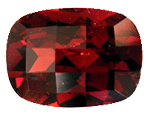
Almandine of typical colour, checkerboard cut
Origin of name: after the city of Alabanda near Miletos and Ephesos in Asia Minor (Turkey). Pliny the Elder mentions Alabanda as a garnet cutting and trade center. Garnets from Alabanda had a reputation of being particularly valuable.
Can be confused with: other red garnets and other red stones like spinel and rubellite (red tourmaline).
Localities: the biggest almandine deposits are in Asia. The most important source is, and has been for thousands of years, India. Most likely the garnets, which the Romans thought to have come from Carthage, Ethiopia and Alabanda, actually were of Indian origin and had found their way to the Mediterranean via the Silk Route.
Interestingly, the Indian garnet deposits are located in the north of the subcontinent, whereas most other Indian gemstones are found in the southern states of Orissa, Tamil Nadu and Karnataka. Only Orissa boasts a sizeable rhodolite deposit, most others are in Rajasthan.
Other important Asian almandine deposits are Pakistan´s Swat Valley, Sri Lanka and Thailand.
The most important almandine localities on the African continent are in Zambia (Mazabika River), Tanzania and in southern Kenya.
Of the numerous other localities all over the world the following three shall be mentioned for reasons of oddity:
In the USA there are many deposits, some of which are quite productive. Unfortunately the greatest part of the material found is of merely mineralogical interest. The USA produced some stunningly large, well-formed crystals of up to 9kgs. One 4.4 kg crystal was found during excavations in New York City, at the intersection of 35th Street and Broadway.
Gem quality almandine is found only occasionally and does not find it´s way to Europe as it is all soaked up by American amateur gem cutters.
Also worth mentioning is the Barton Mine in the Adironback Mountains, New York State, which was founded at the end of the 1880ies by Henry Barton. When Young Henry was a jeweller´s apprentice, he was shown some garnets which a customer had found. Several years later Barton set up a shop for woodcarving and abrading tools in Philadelphia. He remembered the garnets and actually located the deposit. As an abrasive those garnets were far superior to the glass and emery paper he had sold so far and the mine was operative until 1984.
Another odd story took place in Australia. At the end of the 19th century substantial amounts of garnets were found in rivers in the Northern Territory and taken for ruby. This of course led to a rush. In no time at all no less than twentyfour ruby companies were founded, which all collapsed immediately, when the real nature of the stones was officially established.
Last but not least we want to point out the formerly substantial deposits in the Ziller Valley and the Ötz Valley in Austria, our home country. The Ziller Valley in particular was home to a thriving garnet industry in the 19th century. The stones were mostly used as abrasives but quite a lot of gem quality material was found, as well. Today no more gemmy garnets are found but the well-grown crystals, sometimes measuring several centimeters, are popular with mineral collectors the world over.
History: since the 17th century Pegu, a former kingdom in what today is Myanmar (Burma), is named as a source of almandine. However, since in all of Burma there are no garnet deposits worth mentioning and since the very few stones, which are found occasionally, are of rather unpleasing brownish red colour, one may safely assume that Pegu almandine actually was Indian almandine. Most likely Pegu was a trade and maybe also a cutting center.
Until the end of the 19th century one also spoke of "Syrian" garnets. Because of their fine purplish red these stones were highly sought-after and fetched rather high prices. However, the word "Syrian" is a corruption of "Syriam", which is the name of a city south of Pegu and south of the former capital of Yangun (Rangoon). Syriam is known to have been a trading center, possibly also for Indian garnets.
Handling: sensitive to heat and acid, otherwise unproblematic
Colour: from orange red to brownish red (overlapping pyrope), pure red to purplish red, the latter being the most desired and most expensive colour. Now, purplish red usually is attributed to rhodolite, which belongs to the pyrope-almandine series. The transition is gradual and to complicate matters even more, there are garnets of pure red, the classical almandine colour, which, because of their chemical composition and their physical properties, actually are rhodolites. In these cases exact classification asks for chemical analysis.
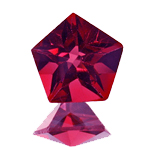
Almandine or rhodolite?
Because such an analysis takes time and money and in general is not an easy thing to do and because traders and customers alike are really and rightfully only interested in genuineness, beauty, value and saleability, the practical thing to do (in the gem trade) is to term all pure red garnets almandines, all brownish or orange red garnets pyropes and all purplish or pinkish garnets rhodolites.
The exceptions are, of course, gem collectors, who always want to know – and in the case of museum collections: have to know – exactly.
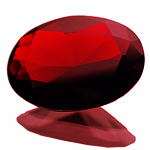
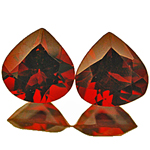
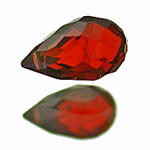
Worth knowing: almandine has very interesting and in part diagnostic inclusions, which do, however, overlap with rhodolite inclusions. Indeed, almandine can be very rich in inclusions, which rather pleases the gemmologist but not so much the buyer, at least not, if the inclusions decrease transparency. Quite often almandine sports a plethora of perfectly grown crystals of apatite, zircon, spinel, rutile and many more. Besides, almandines of some sources regularly show feathers of liquid inclusions, aptly termed "fingerprint inclusions" in gemmology. In rare cases one may find so-called two-phase inclusions, which are cavities filled with either a fluid and a crystal or a fluid and a gas bubble.
Amongst the most common and the most interesting inclusion minerals is rutile which forms needle-like crystals. If these rutile needles are present in the right number, length and thickness and if, moreover, they are oriented along the crystal axes, they may cause a phenomenon called "asterism": incoming light is reflected by the rutile needles to form a star, in the case of garnet a (mostly) four-rayed star, on the surface of the stone. For this phenomenon to be visible, the stone must be cut "en cabochon" and it must be illuminated by a single light. Sunlight is best but halogen spot and even a plain light bulb will do nicely. The star effect will not be seen in facetted gems or in diffuse light like an overcast sky or the light of a fluorescent tube.
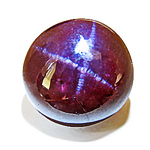
Asteriated garnet is quite rare, little-known and thus hardly ever used in jewellery.
6-rayed star garnets are also known but even rarer then 4-rayed star garnets.
Garnet shop
 Deutsch
Deutsch